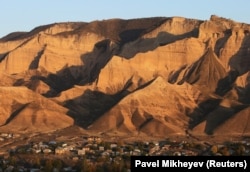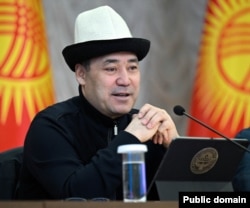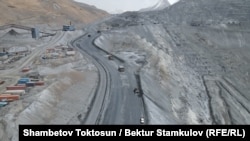ALMATY, Kazakhstan -- Kyrgyzstan’s decision to ban uranium mining in 2019 was a hard-won victory for civil society and an acknowledgement of the tortured environmental legacy of industry during the Soviet era.
But Kyrgyz officials are now calling for the ban to be lifted, as populist President Sadyr Japarov continues his pursuit of state-led production in the extractive industries that he first championed more than a decade ago as an opposition politician.
And while the head of state eyes a new cash cow, other officials are speaking excitedly about a development at the other end of the nuclear fuel cycle -- a small atomic power station that Russia’s Rosatom is set to build to help plug the Central Asian country’s power deficit.
“These two things are probably not without a connection,” said Kalia Moldagazieva, a career environmental campaigner who was among those pushing for the ban five years ago.
“After all, for a nuclear power plant you need uranium. That means they will either have to bring it into the country, perhaps from Kazakhstan, or they will try to enrich it here. However they do it, we are firmly against it,” she told RFE/RL.
A Uranium Mining Present…
February 26 marked the beginning of a public discussion period for a law that would undo the uranium ban put in place when Japarov’s ousted predecessor, Sooronbai Jeenbekov, was in power.
That will end on March 25, with lawmakers set to consider the bill shortly afterwards.
But it seems very unlikely the moratorium will remain in place, as the president has a solid record for getting his way due to the Jogorku Kenesh’s (parliament) habit of nodding in agreement to his policies.
Addressing locals in his native Issyk-Kul Province last week about plans to develop Kyzyl-Ompol -- a uranium deposit licensed to a private investor at the time the ban was enforced -- Japarov said the site would now be “100 percent” developed by the state.
By way of comparison, he mentioned Kyrgyzstan’s largest gold mine, Kumtor, which his government seized in the first months of his presidency. The mine’s former operator, Canada’s Centerra Gold, later agreed to a settlement.
“Firstly, more than 1,000 jobs will be created. You yourselves will work here,” Japarov told an audience that included residents of the Tong district of Issyk-Kul where Kyzyl-Ompol is located.
While local people will “get rich,” Kyzyl-Ompol will become “a second Kumtor,” he pledged.
Curiously, Japarov also noted that Kyrgyzstan intends to send 50 people to Russia for training every year, enabling them to “become specialists in the development of rare earth metals and uranium,” without offering further details.
Japarov’s emphasis on economic impact glosses over the fact that opposition to the development of Kyzl-Ompol both locally and in Bishkek in the run-up to the ban was primarily motivated by environmental concerns connected to the picturesque Issyk-Kul lake, the country’s premier tourism hub.
Kyrgyzstan and the Central Asian region were at the toxic end of the Soviet Union’s nuclear industry.
For more than two decades from the end of World War II, a uranium mine and plant in the southern Kyrgyz town of Mailuu-Suu produced the fuel for the Soviets’ first atomic bomb.
That weapon was tested in 1949 at the Semipalatinsk test site in northeastern Kazakhstan, the first of hundreds of tests that would have devastating environmental and health consequences for the area’s population.
Mining and processing of uranium in Mailuu-Suu ended in 1968, but by that time the area was already highly contaminated thanks to a tailings dam failure in 1958 and the systematically careless disposal of radioactive materials.
Mailuu-Suu, positioned upstream of the densely populated Ferghana Valley, is still home to more than 20 uranium tailings dams containing nearly 2 million cubic meters of toxic material, some of which are dug into the banks of the local river. Incidences of diseases are higher in the town than in other parts of Kyrgyzstan, and a natural disaster in this mountainous, seismically active neighborhood could have ramifications for millions of people.
Another uranium mining legacy site is Ming-Kush, in the adjacent Naryn Province, where remediation works funded by the European Bank for Reconstruction and Development (EBRD) have helped to better secure stores of toxic waste and decontaminate the area.
But there are plenty of other smaller-scale toxic waste sites across Kyrgyzstan that still require cleaning up more than three decades since the country gained independence.
…And A Nuclear Future?
For the moment, Kyrgyz officials seem to view uranium as a future source of hard currency from exports.
While Kyzyl-Ompol will definitely not become a “second Kumtor” in terms of all-round economic significance, Kyrgyzstan needs as many sources of income as it can to shield itself against a potential drop-off in output at the flagship mine that has been producing gold since the 1990s.
Kumtor’s gold production fell to 13.6 tons last year from 17.3 tons in 2022, and the government has said an accumulation of relatively low-grade ore means that production might remain at a similar level in the near future.
This year, the government announced the beginning of underground mining at the 4,000-meter elevation site -- rather than just open-cast mining -- in order to boost production, a move that will attract capital investment.
But the government's uranium-mining drive comes at the same time as the idea of a Russian-built nuclear facility in Kyrgyzstan looks increasingly realistic -- and equally controversial.
Moscow has been keen to position itself as the answer to Central Asia’s yawning energy deficits of late, and Rosatom has been an important part of those efforts. But signoff on the project has been slow.
An agreement for a giant $11 billion nuclear power plant (NPP) in Uzbekistan had looked done and dusted in 2018, when Russian President Vladimir Putin visited the country.
But Uzbek Energy Minister Zhurabek Mirzamakhmudov said in late November that Uzbekistan was considering the “experience and technologies” of other countries as well as Russia, and suggested that any potential nuclear facility might be smaller than initially envisaged.
Those remarks struck a rather different tone to those of Rosatom chief Aleksei Likhachev, who said earlier that month that his company was in the “concluding stage” of talks with Uzbekistan on the NPP.
Then there is Kazakhstan, where President Qasym-Zhomart Toqaev has said at least twice -- most recently in a national address in September -- that his country will hold a popular referendum on building an NPP.
Ahead of a visit to Astana last fall, Putin confirmed Rosatom’s interest in building an NPP “that would meet high international standards in the sphere of environmental protection and safety rules.”
But amid significant public opposition, no date for the Kazakh referendum on nuclear power has been set, and the sound of crickets is growing louder.
If either of those two countries are getting cold feet, it would be understandable.
Russia’s full-scale invasion of Ukraine in 2022 saw its military seize control of the gigantic Zaporizhzhya NPP, raising fears of a potential meltdown amid fierce fighting between the two countries and leaving Moscow facing accusations of gross irresponsibility.
Sweeping Western-led sanctions targeting the Russian economy are another factor that potentially complicate Russian megaprojects abroad, even if Rosatom -- a key player in the global nuclear economy -- is not currently among the companies targeted.
NPPs also take years and years to build.
Kyrgyzstan, for its part, seems to have no compunctions about moving ahead with a deal.
The Kyrgyz nuclear facility would naturally be much smaller than those being planned in its larger neighbors, but the blueprint is already growing.
Speaking at a February 9 roundtable in Bishkek, Deputy Energy Minister Sabyrbek Sultanbekov said Bishkek was looking at a 300-megawatt Small Modular Reactor (SMR) capable of providing electricity for hundreds of thousands of homes rather than two miniplants that would each have a 50-megawatt capacity.
Rosatom and Kyrgyzstan signed a memorandum of cooperation for the smaller plants in January 2022 at the World Expo-2022 in the United Arab Emirates.
Kyrgyzstan’s nuclear needs, Sultanbekov said, were dictated by climatic pressure on hydroelectric power, which accounts for around 90 percent of domestically produced electricity.
“We are going through a drought period. We are coming out of it but the shortage has driven us into conditions whereby we have to import electricity,” said Sultanbekov as reported by Kaktus Media.
"Last year we imported about 2.7 billion kilowatt hours of electricity from Kazakhstan and Turkmenistan. We must have an alternative that does not depend on natural conditions [as water does]. And this alternative is nuclear energy."




